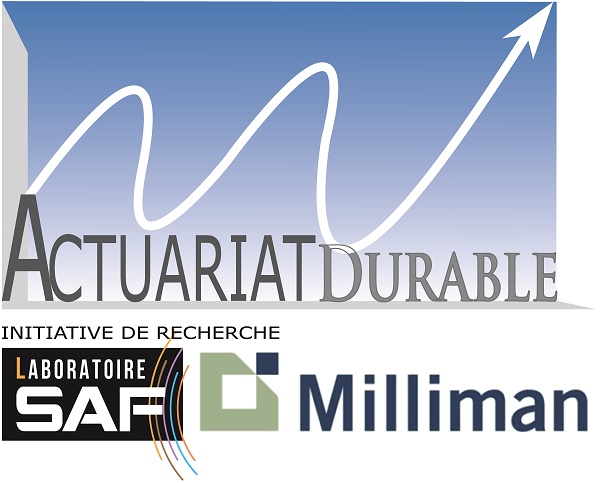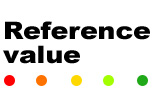Academic chairs, research projects & collaborative projects
Research chairs
As part of our business-lead sponsorships, academic chairs aim to develop a teaching and research expertise on jointly-defined topics
The SAF Laboratory creates a team, spearheaded by a renown scientific figure, which develops research activities over the period of their tenure (1 to 5 years). These academic chairs allow us to merge excellent-standard research activities and knowledge-sharing within our student body.
The keywords normally associated with our academic chairs are prestige and excellence. This means they are held in high repute within the scientific and professional worlds.
Milliman Chair

The “Lasting Actuarial Work and Stability of the Long-Term Insurance Sector” research chair, which is financed by Milliman, has the objective to promote research in the fields of:
- Ruin theory for finite time and infinite time;
- Long-term insurance risks (non-life insurance, longevity, …);
- Correlations and systematic risks.
Research projects and collaborative projects
ANR (“Agence Nationale de la Recherche”, i.e. the National Agency for Research) is assigned with the mission “to handle large state investment programs in the fields of Higher Education and Research, and to ensure their implementation.”
As a state agency funding research projects, it is aimed at both public research establishments and businesses with a dual goal: producing new knowledge and encouraging interactions between public and business laboratories by developing partnerships.
ANR selects the funded projects during proposal periods for which the criteria are; the quality of the scientific aspect of the project, as well as the economic relevance for the companies behind the project.
In France, FUI (“Fonds Unique Interministériel”, i.e. Single Interministerial Funds), financed by the business competitivity funds (“Fonds de Compétitivité des Entreprises”, FCE), supports applied research, through collaborative R&D projects (large groups, SMEs, laboratories) certified by the innovation centres. These projects, for which there are 2 a year following the proposal period, aim to develop new products or services likely to be marketed on a short-term or long-term basis.
ANR LoLitA


Chosen by the the National Agency for Research (ANR), the LoLiTa project which is headed by Stéphane Loisel (ISFA, Univ. Lyon 1) brings together 29 researchers from various laboratories in France and abroad.
The LoLiTa project (Dec. 2013 – Dec. 2017) aims to offer a long-term modelling of human longevity’s uncertain development as well as risk management methods associated with longevity in the fields of pensions, life-insurance and long-term health risks (dependency).
FUI "Reference Value"

ISFA’s SAF Laboratory is one of the eight partners involved in the “Reference value” consortium chosen as a project of excellence in innovation by the Single Interministerial Funds.
Our goal is: establish, control and share the value of companies (listed or not listed on the Stock Exchange or unlikely to be) according to a patented, standardised and public calculated model which takes into consideration financial, economic and immaterial business performances.
AMBIGUITY, INFORMATION SHARING AND MARKET COMPETITION IN INSURANCE
Following the development of data analytics, today, new technics provide the insurance market the possibility to study global risks (climate change, longevity, …) which affect every policyholder’s policy. However, the effectiveness of these methods requires that those who possess databases (i.e. insurance companies) agree to pool them. These large datasets take on the characteristic of a public good.
The sharing of information strengths our knowledge of risk distribution and thus reduces the ambiguity in a universe were policyholders are hostile about uncertainty. Though the advantage of creating such a public good (large datasets) seems almost self-evident, there still remains a necessity to encourage certain people to provide the information.
If we wish to understand the lack of sharing, we place ourselves in a situation where multiple monopolies coexist and are each designed for a different client base in the presence of an alternative selection. Each monopoly has its own client database which only provides imprecise information about their policyholders’ selection bias, with respect to the market risk statistic.
Utilising a large shared dataset reduces imprecision and is supported by policyholders’ hostility to uncertainty. However, on the other hand, the more the supply grows, the greater the knowledge of the insurance market will be. Therefore, ultimately, the greater the knowledge of potential competitors will also be, opening up the market to competition by challenging the former monopolies.
MORTALITY
MEASUREMENT, MONITORING AND ANTICIPATION OF MORTALITY DRIFTING IN INSURANCE PORTFOLIOS:
In 2012, the “Mortality” work group of the “Institut des Actuaires” launched a study with the objective of providing life-insurance operators mortality references and the methodology for an organisation to construct a prospective life table reflecting their portfolio’s experience. This study has enabled the enhancement of work, previously conducted within this context, by introducing a dynamic dimension into the methodology put forward. As soon as the mortality reference is established, it is a matter of being able to detect the changes in the dynamics of the underlying risk. This approach raises questions about the validation of the life table with reference to the additionally collected information concerning the previous years, as well as the setting-up of a surveillance and continuous monitoring process which initiates a sequential detection mechanism for tendency ruptures.
Academic chairs and previous research projects
ADD'AGE
The FNAQPA (“Fédération Nationale Avenir et Qualité de vie des Personnes Agées”), are proactive in their mission to contribute to the qualitative evolution of the accompaniment of elderly people, is initiating a national action-research project for the societal responsibility of establishments and services pertaining to elderly people.
In the context of the ADD’AGE project (January 2014 – December 2015), the laboratory received 50,000€ in financing thanks to the co-financing of the AGIRC ARRCO mutual fund and the “Caisse Nationale de Solidarité pour l’Autonomie” (CNSA, i.e. National Solidarity Fund for Autonomy).
DECAF
The DECAF project is a research initiative conducted by SAF Laboratory researchers around the issue of financial instruments depreciation.
The institutional investors (first amongst them being insurance organisations and credit establishments) hold, and in certain cases release, financial instruments (stocks, bonds, UCITS, forward and derivative contracts, etc.) in significant quantities. For financial reporting purposes, the later are usually priced at their amortised cost, historical value or their current value. In these different situations, the accounting references (e.g. French GAAP) or financial reporting references (e.g. IAS/IFRS) set out the evaluation criteria of the assets and liabilities and plan the accounting depreciation rules (i.e. loss of income) c.f. Thérond (2012)
The aim of the research project is to examine these various measures and to enhance the analysis of the actuarial and financial mathematics tools.
More precisely, the research fields spread over:
- The analysis of the effectiveness of the selected – or evolving – criteria by accounting standard-setters;
- The analysis of practices;
- Recommendations for their implementation (choice of parameters, detection of a significate depreciation, integration of the business modal) c.f. Salhi & Thérond (2014);
- The determination of quantitative piloting results c.f. Azzaz and al. (2014).
This creates an innovative link between accounting research and financial mathematics.
GENERALI Chair, 2010-2015
Generali financed, for over 4 years, the chair called “Responsible Actuarial Work: Management of Natural Risks and Climate Change”. The support from Generali on this topic leads to the strengthening of the natural risks management branch of the SAF Laboratory and the hiring of researchers to work on the risks associated with climate change.
Other projects
- ANR AST&Risk Project, from 2009 to 2012, brought together researcher around the topic of spatiotemporal modelling of risks.
- MIRACCLE Project : Le ministère de l’Ecologie, de l’environnement et du Développement Durable (The Ministry of the Environment, Energy and the Sea), in 2010, chose the MIRACCLE project (“Mesures et Indicateurs de Risques Associés au Changement CLimatiquE”, i.e. Measures and Risk Indicators Associated with Climate Change), headed by the Laboratory of Mathematics at the University of Montpellier, the SAF Laboratory and the Laboratory of Climate and Environment Sciences of the University of Versailles. This project had the objective of providing tools and mathematical methods to measure the impact of climate change on the economy. It was financed for three and a half years, from October 2010 to June 2014.



 en
en fr
fr
